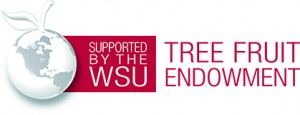Written by Tory Schmidt, Washington Tree Fruit Research Commission, April 3, 2025
If you’ve heard me give a presentation on chemical thinning over the past decade, you might remember me talking about metamitron, a postbloom thinning agent registered in most other apple producing nations around the world that looked promising in our local trials. I probably told you the same thing for several years: that Adama, the owner of that chemistry, was working on registration in the US and hopefully it would be available for commercial use “soon.” At long, long last, the EPA and WSDA have finally approved Brevis TM SC for postbloom chemical thinning on apple and pear and WA growers should be able to purchase product now. Note: product registration is underway in other states but may not be completed in time for the 2025 chemical thinning season.
One upside of this lengthy registration process is that we have had ample time to evaluate metamitron on numerous varieties in many locations under variable weather conditions in Washington. We have learned many things about application rates, timings, and tank mixes with metamitron and have been able to evaluate the effects of all these treatments on trees, fruit set, fruit quality, and return bloom. Here are some key points based on our findings and observations through 14 years of WA Tree Fruit Research Commission (WTFRC) field trials with metamitron that may be helpful as you consider your first attempts at thinning with Brevis TM SC:
Mode of action
Metamitron was originally developed as an herbicide for sugar beet production. It triggers a temporary inhibition of Photosystem II in the chloroplasts of plant cells, reducing the production of photosynthates, somewhat like the effect of shade. This can induce temporary stress in fruit trees due to limited availability of carbohydrates, causing the tree to abort some of its developing fruitlets. This effect is amplified if the tree is already prone to stress due to poor soil conditions, winter damage, and especially by hot, humid, cloudy weather around the time of application.
Timing
The Brevis TM SC label requires that applications be made between late petal fall (5-7 mm fruitlet size) and 16-20 mm fruitlet size. Most of our trial work included applications made at petal fall and 8-12 mm fruitlet size, but we did see some efficacy with metamitron as late as 20 mm, a timing at which most other postbloom thinners have little effect under WA conditions. Our experience has been that metamitron is effective at the same traditional timings (petal fall and 10 mm) that standard postbloom thinning programs are typically applied. With all other conditions being equal, apple trees are most susceptible to most postbloom thinning agents around 10-12 mm fruitlet size, when they are usually running out of carbohydrate reserves from the previous season and their leaf area isn’t adequately developed to provide enough new photosynthates. In other words, your best chance of having success with Brevis TM SC or most other postbloom thinners is in warm weather around 10-12 mm.
Rates
Due to the relatively low stress levels our trees enjoy during spring, we need to be more aggressive with our applications in WA to achieve results similar to those from more modest approaches in most other pome fruit producing regions. The Brevis TM SC label allows a range of 16-48 fl oz/acre in WA and requires the use of a non-ionic surfactant (NIS), which has consistently improved efficacy in WTFRC trials. When deciding which rate to use, WA growers might consider starting with 32 fl oz/acre + NIS as a “baseline” and bumping that number up or down depending on other factors including the strength of their bloom thinning program, difficulty of thinning a particular block/variety, and weather conditions. For example, a Cripps Pink (relatively easy to thin) block that received two blossom thinning sprays with a forecast of overcast skies and temperatures in the 80s might do well with a rate of 24 fl oz + NIS. Conversely, a Fuji (relatively difficult to thin) block that received no blossom thinners and facing a forecast of clear sunny skies with temperatures in the 60s should probably consider a more aggressive rate like 40 fl oz/acre + NIS. As with all other chemical thinners, growers and consultants will learn how best to use Brevis TM SC in their own scenarios with firsthand experience.
Phytotoxicity
We have seen a wide range of phytotoxic reactions on the leaves of trees treated with metamitron in WTFRC trials. In most cases, there has been no visible damage to leaves at all, but occasionally, we have observed some chlorosis/mottling in between the veins of primary leaves, as well as some marginal leaf burn similar to what we have seen from ATS or lime sulfur (Figure 1 and Figure 2). The most severe cases of phytotoxicity have been associated with the use of experimental adjuvants like oils and silicone-based surfactants applied with metamitron when temperatures were in the 90s. Even in those cases, the trees quickly grew out of that condition, making it difficult to find any evidence of phytotoxicity 2-3 weeks after application. Growers should follow the Brevis™ SC label directions, which require the use of a non-ionic surfactant and applying when temperatures are forecasted to be below 84°F for 1-5 days after application. The label prohibits the use of crop oil concentrate (COC), summer horticultural oil, or tank-mixing with any oil-based formulation. When applied according to these directions, there should be very little risk of significant phytotoxicity. Most importantly, we have never observed any damage to treated fruit, which has been consistently clean in WTFRC trials.


Efficacy
Metamitron has proven itself to be an effective chemical thinner in WTFRC trials; in fact, no other postbloom thinning treatment has been more consistent at delivering significant reductions in fruit set or increases in fruit size and return bloom (Table 1). In our experience, metamitron can still be effective in cool conditions (i.e. temperatures in the 60s), but its performance is certainly enhanced when temperatures are in the 70s and 80s. We have seen some cases of overthinning from applications of high rates made in the high 80s and 90s, so growers should follow the label recommendation of not applying in temperatures above 84°F.
Table 1. Incidence of results significantly superior to untreated control. WTFRC apple chemical postbloom thinning trials 2002-2024
| Treatment | Fruitlets / 100 blossom clusters | Harvested fruit size | Return bloom 1 |
|---|---|---|---|
| BA | 8 / 33 (24%) | 0 / 35 (0%) | 0 / 33 (0%) |
| Carbaryl + BA | 33 / 92 (36%) | 10 / 90 (11%) | 13 / 86 (15%) |
| Carbaryl + NAA | 30 / 88 (34%) | 23 / 88 (26%) | 19 / 85 (22%) |
| BA + NAA | 20 / 42 (48%) | 9 / 41 (22%) | 9 / 38 (24%) |
| Metamitron | 21 / 38 (55%) | 12 / 37 (43%) | 10 / 34 (29%) |
1 Does not include data from 2024 trials
Pears
Although our database of pear thinning trials isn’t nearly as vast as it is in apple, we have observed statistically significant reductions in fruit set and improvements in fruit size from equivalent applications of 16-30 fl oz/acre Brevis TM SC in recent Bartlett trials. We plan to continue working with metamitron in the coming years to learn more about best use practices for pear thinning.
Other considerations
- Brevis TM SC is safer for honeybees and other pollinators than carbaryl products and is considered “reduced risk” by the EPA.
- Adama has developed a model called BreviSmart to predict a tree’s carbohydrate status based on weather conditions to help guide decisions about appropriate rates and timings of Brevis TM SC applications. Consult your crop advisor for more information.
- Learning how to use new thinning chemistries takes time and experience; consider testing new products on smaller portions of your acreage until you gain more confidence.
Contact
Tory Schmidt
WA Tree Fruit Research Commission
tory@treefruitresearch.com
www.treefruitresearch.org
(509) 669-3903
Fruit Matters articles may only be republished with prior author permission © Washington State University. Reprint articles with permission must include: Originally published by Washington State Tree Fruit Extension Fruit Matters at treefruit.wsu.edu and a link to the original article.
Use pesticides with care. Apply them only to plants, animals, or sites listed on the labels. When mixing and applying pesticides, follow all label precautions to protect yourself and others around you. It is a violation of the law to disregard label directions. If pesticides are spilled on skin or clothing, remove clothing and wash skin thoroughly. Store pesticides in their original containers and keep them out of the reach of children, pets, and livestock.
YOU ARE REQUIRED BY LAW TO FOLLOW THE LABEL. It is a legal document. Always read the label before using any pesticide. You, the grower, are responsible for safe pesticide use. Trade (brand) names are provided for your reference only. No discrimination is intended, and other pesticides with the same active ingredient may be suitable. No endorsement is implied.

